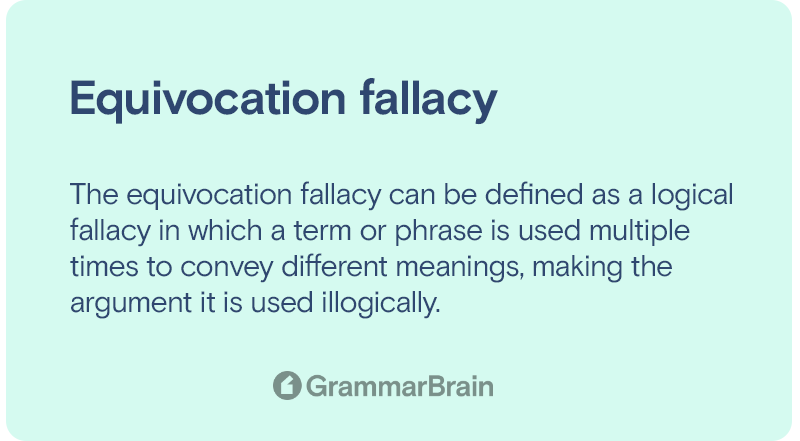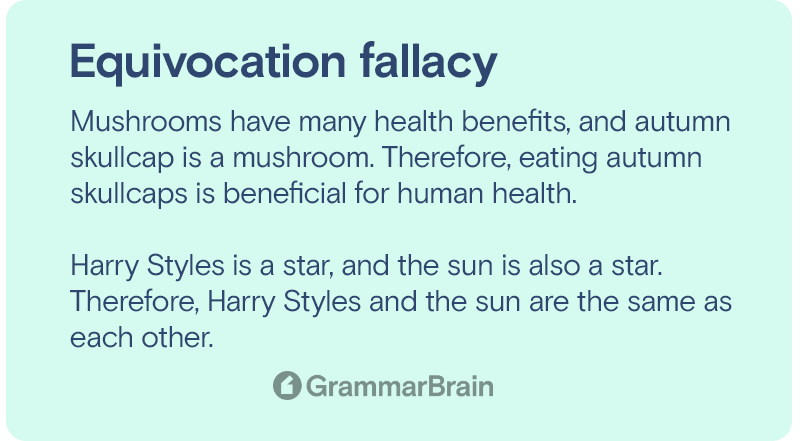What is equivocation fallacy? Equivocation is the purposeful use of ambiguous or vague vocabulary with the goal of misleading people or avoiding taking a stand. An individual is equivocating when they respond evasively to a direct question with a general statement that does not address the query.

What is the equivocation fallacy?
The equivocation fallacy can be defined as a logical fallacy in which a term or phrase is used multiple times to convey different meanings, making the argument it is used illogically. The equivocation fallacy happens in two ways:
- When words or phrases are used in ambiguous ways
- When the word used means more than one thing in the sentence
Consider the following sentence:
This statement is fundamentally wrong since the words “bark” used in the first and second parts of the sentence mean entirely different things. This fallacy in the argument is the equivocation fallacy.
In many cases, authors may use the equivocation fallacy to create a humorous situation or to discuss an important argument laced with humor.
But in many cases, the equivocation fallacy may be used to support a claim of bad faith. “Bad faith argument” refers to a stance that the person making the claim knows their claim is false or not fair.
People usually use these in an effort to avoid being forced to take the problems at hand seriously and to circumvent admitting that their adversaries’ viewpoints are reasonable, as well as substantiated.
There are other fallacies in the English language similar to the equivocation fallacy that can be used to support a claim of bad faith. These include the red herring and straw man fallacies.

Structure of the equivocation fallacy
Since the equivocation fallacy is informal in nature, more importance is given to the application of the argument than its structure.
The general format of an equivocation fallacy is “If A is B and B is C, then C must be A.”
Examples:
- Mushrooms have many health benefits, and autumn skullcap is a mushroom. Therefore, eating autumn skullcaps is beneficial for human health.
- Harry Styles is a star, and the sun is also a star. Therefore, Harry Styles and the sun are the same as each other.
- Loud horns in the traffic give me a headache. Ibuprofen is good for reducing headaches. So, ibuprofen can help me get rid of loud horns in traffic.
- Cats are good pets. Tigers are huge cats. Therefore, tigers are good pets.
In the sentences given above, it is easier to spot the equivocation since the logical absurdity is clearly seen.
But in some cases, the fallacy may not be in a format similar to the above sentences. It is also used for lying by omission.
Consider a situation where a cosmetic company is advertising a new moisturizing face cream they have introduced into the market. The company may only enumerate the positive features or effects of the cream.
They may hide the fact that prolonged use of the cream may lead to skin cancer, even if they are aware of it.
This “lying by omission” can also be considered a subset of the equivocation fallacy.
Some concepts relevant to equivocation
Equivocation is an obfuscation technique that’s quite common. There are certain concepts associated with equivocation that help a reader form a better understanding of the technique. Some of them include:
Doublespeak
Doublespeak can be defined as communicating something in a manner that distorts or conceals the truth. This is done with the intention of hiding the real message behind the words and confusing the reader or listener.
Doublespeak is occasionally used to reduce the effect of the message on the audience, especially when the message is conveying a negative event. But it is more frequently employed to hide the truth.
Examples:
- using “collateral damage” rather than “multiple fatalities”
- using “reducing costs” rather than “cutting jobs”
- using “ethnic cleansing” rather than “genocide”
- using “alternative facts” rather than “misinformation” or “lies”
Circumlocution
Circumlocution can be defined as the process of using words more than required to convey a message with the intention of being ambiguous, evasive, or deceptive. For instance, a politician may employ circumlocution by providing a lengthy and ambiguous answer to an inquiry in an effort to conceal the fact that they did not actually address the topic.
Circumlocution can be considered a kind of equivocation. Thus, circumlocution might be seen as a particular kind of equivocation. But keep in mind that, like equivocation, this type of communication is not always motivated by bad intentions. People often mistakenly use too many words when they are forced to bring up a subject that makes them uncomfortable.
Humor and equivocation fallacy
An equivocation fallacy can be frequently employed in a comedic context. Puns, for instance, are hilarious methods that occasionally depend on the premise that a single word can have multiple meanings. Consider the following joke:
“Donald Duck walked into a bar and ordered a whisky neat. The bartender said,” $5.” Donald Duck replied, “Put it on my bill.”
Here, the bill can be interpreted in two ways:
- the printed statement of the money owed for the whisky
- the beak of the bird.
This ambiguity gives it a comedic quality.
Quibbling
Quibbling is when someone makes a flawed attempt to refute an argument by interpreting one of its terms differently than it was intended to be understood.
Literature and equivocation fallacy
There is an abundance of equivocation fallacy examples in literature. The famous Shakespearean tragedy Macbeth is an example of how a skilled writer can use the equivocation fallacy to create suspense and twists in the story.
The phrase “none of woman born” is used in the play to denote the way Macbeth will die.
The reader draws the inference that no individual born of a woman will be able to kill Macbeth. But Shakespeare used this term to simply mean that a person who was born naturally will not be able to kill Macbeth.
The author here is quiet about a person who was born through a Caesarean procedure. This is lying by omission or an equivocal fallacy. This is proven when Macbeth is killed by Macduff, a man born by Caesarean birth (“from his mother’s womb / Untimely ripped”) or as the author said, “none of woman born.”
FAQs
How can a reader identify the equivocation fallacy?
Critical thinking is necessary to identify the equivocation fallacy and to separate fact from the author’s opinion. A reader should carefully consider both the starting argument and the ending opinions of the author to identify the discrepancy between them. The reader should not be focusing on the correctness of the two facts presented but rather on the logical connection shown between them.
Can authors use the equivocation fallacy in any form of writing?
Many authors use the equivocation fallacy to create funny situations, especially in fiction. It may also be used by authors when writing suspenseful fiction to deliberately mislead the reader.
How can the equivocation fallacy be avoided when writing?
Authors can avoid the equivocation fallacy by giving a clear and concise explanation of the topics they are discussing. Avoiding synonyms alone to maintain uniform terminology and then continuing with conceptual consistency can also be helpful.
Sources:
- Merriam Webster – equivocation – Definition
- Wikipedia – Equivocation
- Britannica – equivocation
- Grammarly – Equivocation Fallacy Explained, with Examples
Inside this article
Fact checked:
Content is rigorously reviewed by a team of qualified and experienced fact checkers. Fact checkers review articles for factual accuracy, relevance, and timeliness. Learn more.
Core lessons
Glossary
- Abstract Noun
- Accusative Case
- Anecdote
- Antonym
- Active Sentence
- Adverb
- Adjective
- Allegory
- Alliteration
- Adjective Clause
- Adjective Phrase
- Ampersand
- Anastrophe
- Adverbial Clause
- Appositive Phrase
- Clause
- Compound Adjective
- Complex Sentence
- Compound Words
- Compound Predicate
- Common Noun
- Comparative Adjective
- Comparative and Superlative
- Compound Noun
- Compound Subject
- Compound Sentence
- Copular Verb
- Collective Noun
- Colloquialism
- Conciseness
- Consonance
- Conditional
- Concrete Noun
- Conjunction
- Conjugation
- Conditional Sentence
- Comma Splice
- Correlative Conjunction
- Coordinating Conjunction
- Coordinate Adjective
- Cumulative Adjective
- Dative Case
- Determiner
- Declarative Sentence
- Declarative Statement
- Direct Object Pronoun
- Direct Object
- Diction
- Diphthong
- Dangling Modifier
- Demonstrative Pronoun
- Demonstrative Adjective
- Direct Characterization
- Definite Article
- Doublespeak
- False Dilemma Fallacy
- Future Perfect Progressive
- Future Simple
- Future Perfect Continuous
- Future Perfect
- First Conditional
- Irregular Adjective
- Irregular Verb
- Imperative Sentence
- Indefinite Article
- Intransitive Verb
- Introductory Phrase
- Indefinite Pronoun
- Indirect Characterization
- Interrogative Sentence
- Intensive Pronoun
- Inanimate Object
- Indefinite Tense
- Infinitive Phrase
- Interjection
- Intensifier
- Infinitive
- Indicative Mood
- Participle
- Parallelism
- Prepositional Phrase
- Past Simple Tense
- Past Continuous Tense
- Past Perfect Tense
- Past Progressive Tense
- Present Simple Tense
- Present Perfect Tense
- Personal Pronoun
- Personification
- Persuasive Writing
- Parallel Structure
- Phrasal Verb
- Predicate Adjective
- Predicate Nominative
- Phonetic Language
- Plural Noun
- Punctuation
- Punctuation Marks
- Preposition
- Preposition of Place
- Parts of Speech
- Possessive Adjective
- Possessive Determiner
- Possessive Case
- Possessive Noun
- Proper Adjective
- Proper Noun
- Present Participle
- Prefix
- Predicate



